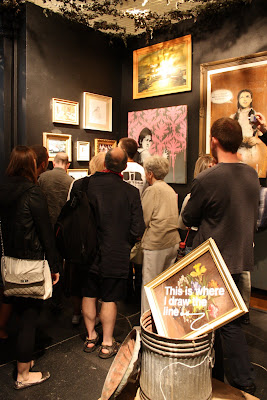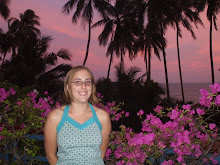
In Shijiazhuang, all Western foreigners looked alike. Brunettes were surprised to hear that they had fair hair: after all, Westerners have blonde hair so as long as your skin was white your hair was blonde. Similarly, green and hazel eyes all blur into one blue haze.
The allure of blue eyes to a Chinese female provincial teenager cannot be overstated. I would find that my normally timid students, who would sometimes stare in the opposite direction to me rather than make eye contact (I believe this is some sort of mark of respect rather than a symptom of avoidant personality disorder), would fix my with a slightly maniacal stare before announcing to me ‘Your eyes are so blue.’ Quite often this nuggest would be repeated several times, as I mumbled something like ‘erm, yes, thanks’ (I mean, really, what can you say?) as the conversation stumbled along the line between endearing and creepy.
One of my older students even went as far as to wear a pair of blue contacts. Worn over her naturally almost black irises the effect was startling to say the least. I didn’t have the heart to tell her that I was more reminded of something from a horror film than anything else, and after all, rare are the women who can honestly say that they were free from fashion faux pas at the age of seventeen.
Thankfully, voodoo isn’t native to China, as our blonde locks (even mine, which are more of a indecisive light browny colour when au natural) were quite the temptation to young students. Not only did I have to tell them that they could not pet my hair, and no, I didn’t believe that they had done it ‘accidentally’, but I actually had to tell some of them not to remove stray hairs from my clothes. Another one of my friends had a student request a hair from her, which she loving pasted into a scrapbook beside her signature.
This perhaps makes them sound odder and me meaner than really was the case. Certainly in Shijiazhuang, often people’s natural response to something unusual was to want to touch it, unaware that this is completely shocking to the Westerner on the receiving end! Also, lacking disciplinary authority, many of my classes, especially amongst the younger students, teetered along the borderline of chaos, and allowing any sort of liberty would result in them collapsing catastrophically.
Similarly, there was a standard image of what Westerners looked like, and no matter your personal appearance, I found that this imaginary prototype Westerner had a far stronger effect on Chinese people’s minds than the individual foreigner standing before them. Surprisingly, this was true not just in Shijiazhuang, but in the polyglot Beijing Silk Market, where the shoppers are almost exclusively foreign and most of the sales assistants speak English of a quality that would make many a Shijiazhuang English major envious.
At home, I am reasonably petite, at five foot four, I wear at size 10 dress and a size 4 shoe, meaning I was around the same size of a lot of Chinese women my age. One of my students once voiced positive outrage that I was the same size as her. However, this didn’t stop shop assistants invariably bringing out shoes or clothes a couple of sizes too big to start with.
On my last visit to the Silk Market I wanted to buy a trench coat (which has already been well used in our British Summer). The assistant insisted that I start by trying on the largest size first, which made me look like I had been assaulted by a parachute. Even then, we had to work our way laboriously through various degrees of L before finally hitting on the very happy Medium.
My small and narrow feet were the subject of scrutiny when I first started working at the school. Amazement at how ‘tiny’ my feet were (by
laowai standards, perfectly normal by Chinese ones), dragged on for the first month or so of my appointment. To begin with, I was quite flattered, but after a week or so I began to have wild fears that someone was going to break into my apartment in the dead of night to chop my feet off (or, at the very least, take a photograph) for the local museum.
 Yes, this photo was taken in July. Yes, it is meant to be summer in the UK. And yes, that is a pier you can see.
Yes, this photo was taken in July. Yes, it is meant to be summer in the UK. And yes, that is a pier you can see.










 The Restaurant was the first place I ever ate in Shijiazhuang, less than 12 hours after getting off the plane. I remember my first horrified, jet lagged, culture shocked reaction: all I could see was shabbiness, grubbiness, and an astonishing lack of hygiene.
The Restaurant was the first place I ever ate in Shijiazhuang, less than 12 hours after getting off the plane. I remember my first horrified, jet lagged, culture shocked reaction: all I could see was shabbiness, grubbiness, and an astonishing lack of hygiene.



 Vinegar potatoes.
Vinegar potatoes.
 We liked to mix our dishes with our rice, unlike most Chinese people who prefer to have their rice plain at the end of the meal
We liked to mix our dishes with our rice, unlike most Chinese people who prefer to have their rice plain at the end of the meal
 You might not believe me when I tell you that the photo of the fish tank was taken at its cleanest. When a customer ordered fish, the chef would come out from the kitchen, reach his hand in, grab one and take it, still flapping pathetically in his hand, to its doom. If the fish managed to leap out of his hand, it would writhe on the floor, sometimes managing to cover a surprising distance before being recaptured. Every time this happened, I would have to stifle the urge to scream and stand on my chair, which is probably slightly strange. Once, after a particularly spirited struggle between man and fish, my friend was horrified to find she had a patch of fish scales in her hair.
You might not believe me when I tell you that the photo of the fish tank was taken at its cleanest. When a customer ordered fish, the chef would come out from the kitchen, reach his hand in, grab one and take it, still flapping pathetically in his hand, to its doom. If the fish managed to leap out of his hand, it would writhe on the floor, sometimes managing to cover a surprising distance before being recaptured. Every time this happened, I would have to stifle the urge to scream and stand on my chair, which is probably slightly strange. Once, after a particularly spirited struggle between man and fish, my friend was horrified to find she had a patch of fish scales in her hair.











 I liked the sudden, shocking reminder of Agency Worker that the anonymous peasants in bucolic English pastorals, for some reason Contable in particular was brought to mind, were not only real humans, but often, far from living in a rural idyll, had to survive shoddy living and working conditions, considerable insecurity and the threat of destitution. How often though, are these people almost invisible to us when we looks at pastoral paintings.
I liked the sudden, shocking reminder of Agency Worker that the anonymous peasants in bucolic English pastorals, for some reason Contable in particular was brought to mind, were not only real humans, but often, far from living in a rural idyll, had to survive shoddy living and working conditions, considerable insecurity and the threat of destitution. How often though, are these people almost invisible to us when we looks at pastoral paintings.






 The guy repeatedly remarked about how she’d told him there wouldn’t be a queue, in a way that was, on the surface, a joke but you could tell underneath he was pissed off and didn’t want to be there and was only doing because he still felt the need to impress her and that in three months time it’d come up in an argument, ‘what about that time you made me stand in the rain for 45 minutes to get into that bloody art exhibition.’
The guy repeatedly remarked about how she’d told him there wouldn’t be a queue, in a way that was, on the surface, a joke but you could tell underneath he was pissed off and didn’t want to be there and was only doing because he still felt the need to impress her and that in three months time it’d come up in an argument, ‘what about that time you made me stand in the rain for 45 minutes to get into that bloody art exhibition.’
 A twenty something man also attracted my attention because he was wearing a university society T-Shirt, which in the UK is normally a sign of being remarkably socially inept, and had an aura of being extremely peculiar. The kind of person who isn’t aware that his fellow students don’t avoid him because he’s different per se, but because his different in a way that suggests it’s only a matter of time before he’s arrested for flashing people or having dodgy pornography.
A twenty something man also attracted my attention because he was wearing a university society T-Shirt, which in the UK is normally a sign of being remarkably socially inept, and had an aura of being extremely peculiar. The kind of person who isn’t aware that his fellow students don’t avoid him because he’s different per se, but because his different in a way that suggests it’s only a matter of time before he’s arrested for flashing people or having dodgy pornography.








